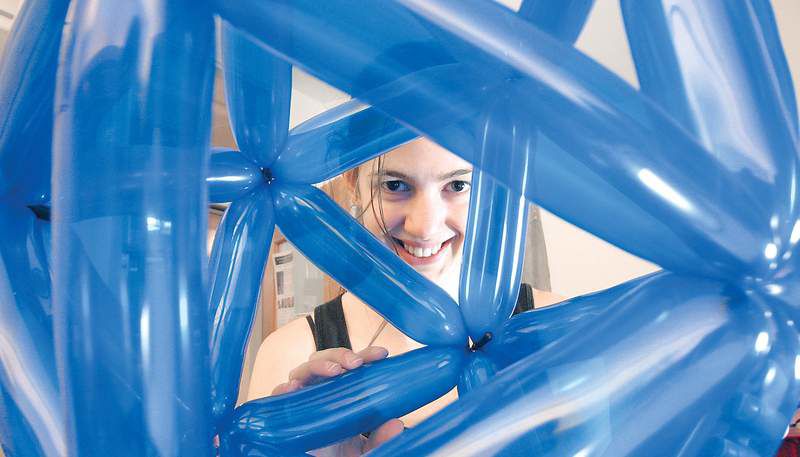Oodles of doodles: On viral videos, ‘mathemusician’ makes math cool
Published 4:00 am Friday, January 21, 2011

- Vi Hart holds an icosahedron made from six balloons. In November, Hart's YouTube video about doodling in math class went viral. She is now receiving job offers to continue her math pursuits.
FARMINGDALE, N.Y. — At the aptly named Tiny Thai restaurant here, a small table, about 2 1/2 feet square, was jammed with a teapot, two plates of curry, a bowl of soup, two cups of tea, two glasses of water, a plate with two egg rolls, a plate of salad and an iPhone. For most people, this would have been merely an unwieldy lunch.
For Vi Hart, her mind pondered the mathematical implications. “There’s a packing puzzle here,” she said. “This is the kind of thing where if you’re accustomed to thinking about these problems, you see them in everything.”
Mathematicians over the centuries have thought long and deep about how tightly things, like piles of oranges, can be packed within a given amount of space.
“Here we’ve got even another layer,” Hart said, “where you’re allowed to overhang off the edge of your square. So now you have a new puzzle, where maybe you want the big things near the edge because you can fit more of them off the edge before they fall off.”
Hart — her given name is Victoria, but she has long since dropped the last six letters — has an audacious career ambition: She wants to make math cool.
She effused, “You’re thinking about it, because it’s awesome.”
Mathemusician
She calls herself a full-time recreational mathemusician, an off-the-beaten-path choice with seemingly limited prospects. And for most of the two years since she graduated from Stony Brook University, life as a recreational mathemusician has indeed been a meager niche pursuit.
Then, in November, she posted on YouTube a video about doodling in math class, which married a distaste for the way math is taught in school with an exuberance for actual mathematics.
The rapid-fire narration begins, “OK, let’s say you’re me and you’re in math class, you’re supposed to be learning about exponential functions, but you’re having trouble caring about exponential functions because unfortunately your math class is probably not terribly engaging.”
The video never shows her face, just her hands doodling in a notebook. She talks about binary trees, Hercules cutting off the heads of a mythical hydra (each severed neck grows two new heads, which is the essence of a binary tree), and a fractal pattern known as Sierpinski’s Triangle.
She did another about drawing stars (really about geometry and polygons). Then another about doodling snakes (which segues into graph theory, “a subject too interesting to be included in most grade-school curricula,” she says). And another about prime numbers. (“Remember, we use prime numbers to talk to aliens. I’m not making this up.”)
The videos went viral, viewed more than a million times.
“You > Chuck Norris,” gushed a fan on her YouTube page.
At first glance, Hart’s fascination with math might seem unexpected. She graduated with a degree in music, and she never took a math course in college.
At second glance, the intertwining of art and math seems to be the family business. Her father, George Hart, builds sculptures based on geometric forms. His day job until last year was as a computer science professor at Stony Brook; he is now chief of content for the Museum of Mathematics, which is looking to open in Manhattan next year.
Hooked at an early age
The summer Hart was 13, she tagged along with her father to a computational geometry conference. “And I was hooked, immediately,” she said. “It was so different from school, where you are surrounded by this drudgery and no one is excited about it. Any gathering of passionate people is fun, really no matter what they’re doing. And in this case, it was mathematics.”
In college, she continued attending math conferences and collaborated on a number of papers with Erik Demaine, an MIT professor best known for his origami creations.
After finishing her music degree — as a senior, she composed and conducted a seven-part musical piece based on the seven Harry Potter books — “I couldn’t focus on one thing or ever see myself fitting into any little slot where I would have some sort of normal job,” Hart said. “If I want to spend a week carving fruit up into polyhedra, I want to spend a week carving fruit up into polyhedra, and where am I going to get a job doing that?”
She did indeed spend a week carving fruit into polyhedrons, posting photographs and instructions on her website, vihart.com.
Drawing attention
Such mathematical musings drew modest amounts of interest. In the fall, she was looking over some of her doodles. She thought of taking photographs of them and writing instructions for those, too, but she decided to try something different. She made her first doodling video.
Working by herself, practically embracing a camera on a tripod, she created a video of her doodling seemingly from the point of view of the doodler.
“I want a real first-person view,” she said, “because I want people to feel they can do this. People can. It’s mathematics that anyone can do.”
The ensuing attention has come with job offers and an income. In one week in December, she earned $300 off the advertising revenue that YouTube shares with video creators. She is also happy that, unlike in her early efforts, which drew an audience typical of mathematics research — older and male, mostly — the biggest demographic for her new videos, at least among registered users, are teenage girls.
“I just think that’s really awesome,” she said, “because you’ve got girls in middle school and high school who are suddenly enjoying mathematics and enjoying being a little nerdy and smart, and we need that.”






